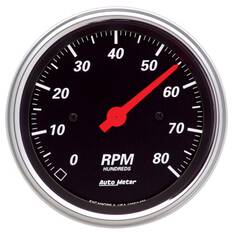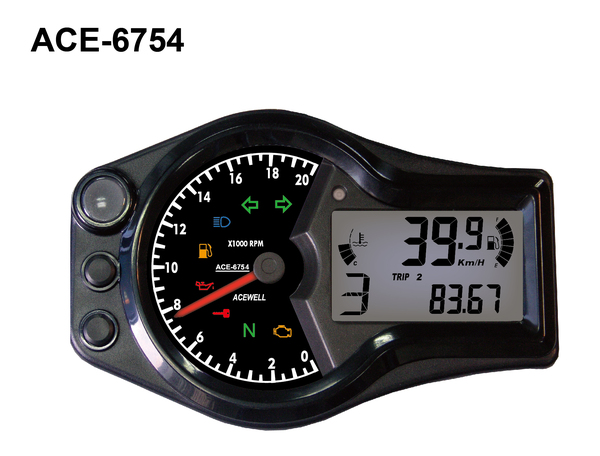Exactly How a Tachometer Assists Monitor Engine Health and Performance
The Importance of a Tachometer in Checking Engine Speed and Efficiency in Automotive Applications
In the world of vehicle design, the tachometer stands as a pivotal instrument in the chauffeur's toolbox, supplying a straight home window right into the internal operations of a lorry's engine. Past its function as a mere gauge of revolutions per minute (RPM), the tachometer serves as an essential tool for lovers and experts alike, using real-time insights right into engine efficiency and health and wellness.
Value of Checking Engine RPM
Checking engine RPM, or changes per min, is an essential facet of auto upkeep and efficiency examination. Engine RPM directly correlates with the speed at which the engine's crankshaft revolves, showing exactly how swiftly the engine is running - tachometer. By keeping an eye on RPM, auto mechanics can evaluate the health of the engine, detect possible problems, and fine-tune performance. An unusual RPM reading might indicate issues such as engine misfires, faulty trigger plugs, or concerns with the gas shipment system. Regularly high RPM readings can show hostile driving practices or the need for a greater equipment shift to boost fuel efficiency.
Moreover, monitoring engine RPM is vital for efficiency evaluation in racing and high-performance automobiles. In recap, monitoring engine RPM is not only crucial for detecting issues however additionally for maximizing engine performance in various automobile applications.

Benefits of Real-Time Data
In vehicle applications, real-time information plays a critical role in providing immediate insights into the performance and condition of the car. By constantly keeping an eye on numerous criteria such as engine rate, temperature level, gas usage, and a lot more, real-time information uses many benefits that add to enhanced efficiency and safety when traveling.
Additionally, real-time data facilitates efficiency optimization by offering prompt comments on driving habits and engine performance. Chauffeurs can readjust their habits in real-time based on this details to accomplish far better fuel economy and extend the life expectancy of their automobile.

In addition, real-time information plays an essential function in modern-day automobile diagnostics, enabling professionals to rapidly detect and deal with breakdowns. This leads to minimized downtime, reduced maintenance expenses, and inevitably, improved general lorry reliability and durability (tachometer). By harnessing the power of real-time data, vehicle stakeholders can make enlightened decisions that positively affect both the efficiency and longevity of the car
Influence on Equipment Shifts
Efficient gear shifts in vehicle applications significantly influence general performance and driving experience. The tachometer plays a critical duty in optimizing gear shifts by offering real-time engine speed information to the driver. When approaching the redline on the tachometer, it signals the chauffeur to upshift to stop over-revving the engine and creating possible damages. On the various other hand, downshifting at the appropriate minute can aid keep the engine in its power band, making certain receptive velocity when required.
Moreover, the tachometer help in attaining smoother equipment shifts, particularly in manual transmissions. By monitoring engine rate, vehicle drivers can implement equipment shifts at the optimal RPM array, lowering jerking motions and minimizing endure the transmission elements. This precision in gear adjustments not just improves driving comfort yet likewise contributes to fuel performance.
Enhancing Fuel Efficiency
Offered the important function the tachometer plays in optimizing equipment shifts for efficiency and engine health and wellness, it directly contributes to taking full advantage of fuel performance in vehicle applications. By offering real-time responses on engine speed, the tachometer assists vehicle drivers in preserving one of the most effective RPM range for gas economy. When vehicle drivers consistently monitor the tachometer and change their driving behaviors appropriately, they can avoid unnecessary gas usage triggered by over-revving or lugging the engine.
In addition, the tachometer assists vehicle drivers identify one of the most fuel-efficient gear to be in at any type of provided moment, stopping the engine from functioning more difficult than essential. This is particularly vital during Related Site acceleration and travelling, where remaining in the best equipment can dramatically impact gas performance. Additionally, the tachometer can notify vehicle drivers to potential mechanical problems that might be adversely affecting fuel economic climate, such as a sliding clutch or a clogged up air filter. In conclusion, the tachometer serves as a useful device in enhancing fuel effectiveness by promoting ideal driving behaviors and recognizing areas for improvement in the car's performance.

Optimizing Engine Long Life
The tachometer's duty in keeping an eye on engine rate and performance contributes in ensuring the long life of automobile engines. By utilizing the tachometer effectively, drivers can maximize engine durability through conscious RPM monitoring. Regularly revving an engine too expensive can lead to too much deterioration on crucial components, such as the pistons, shutoffs, and bearings. In time, this click this link can result in lowered engine performance and possible malfunctions. Monitoring the tachometer permits chauffeurs to stay within the advised RPM range for their lorry, stopping unnecessary stress on the engine and extending its life-span.

Verdict
Finally, the tachometer plays an essential duty in keeping track of engine rate and performance in automotive applications. By supplying real-time data on RPM, it permits efficient equipment changes, improved gas efficiency, and maximized engine durability. This device is vital for keeping ideal engine efficiency and guaranteeing the general functionality of an automobile.